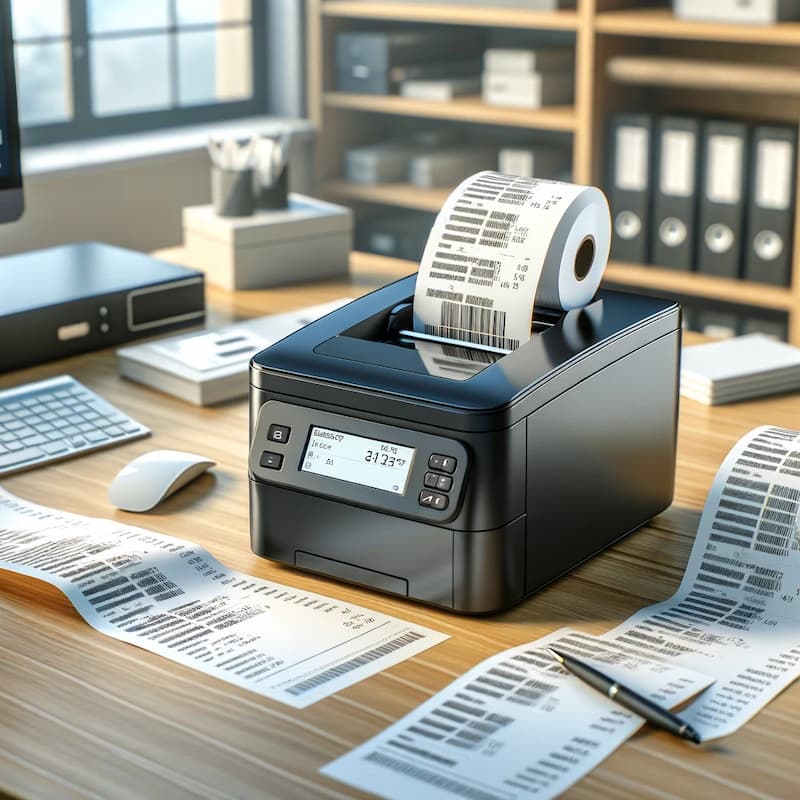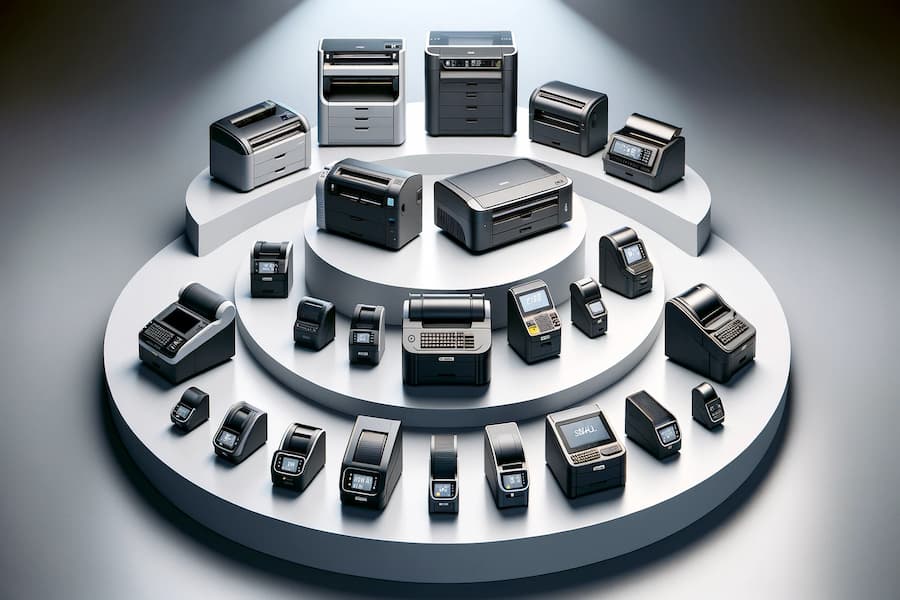The Ultimate Guide to Thermal Printers
Thermal Printers
In a world where rapid and error-free printing forms the backbone of many industries, thermal printers stand as the unsung heroes. These dynamic machines, unlike their counterparts, wield the power to churn out high volumes of labels, tickets, and other media with unmatched efficiency. The humming sound of thermal printers, harmonized with the rhythmic spitting out of print media, resonates as the heartbeat of bustling organizations.
The allure of thermal printers lies not just in their capacity for high volume work but also their unique working principle. While most printers rely on ink or toner, thermal printers employ heat to produce images and text, a distinctive feature that sets them apart. As a thermal printer technician, the intricacies of these machines don’t simply represent a complex mesh of parts and principles; it’s a symphony of technology, with each component playing its part in creating the perfect print.
What Is a Thermal Printer?
Delving into the specifics of heat-based impression technologies, first consider direct thermal printing. This method, employed by devices like a direct thermal printer, uses heat-sensitive, chemically treated material, such as thermal paper, to generate text or images. However, note that this is ideal for short-term use, since exposure to light or heat can fade the output over time.
On the other hand, thermal transfer printing, used by thermal transfer printers, involves a thermal printhead transferring solid ink from a ribbon onto a label, rendering it suitable for long-term use. Great for barcode or shipping label applications, this method ensures high print quality and durability.
Direct Thermal Printing Explained
Diving deeper into the labyrinth of heat imprinting methods, let’s spotlight the marvel of Direct Thermal Printing. Imagine a device, a label printer that spews out receipts or labels with such efficiency that it would seem like magic. This type of printer, a direct thermal label printer, like the munbyn thermal, needs no inkjet cartridge or ribbon to print labels.
How do these printers work you ask? The magic lies in the heat-sensitive media that they use. When the thermal print head glides over the media, the heat causes the material to darken, manifesting as the image or text needed. This is the secret behind the rapid print speed. However, this magic has a particular Achilles heel – light and heat can cause the media to darken further or the printed image to fade.
While the printer may be the best label choice for small businesses, it’s important to note that labels or receipts printed using this method are not ideal for long-term use or exposure to harsh conditions.
Thermal Transfer Printing Explained
Diving deeper into the technicalities, thermal transfer printers use a different mechanism. Imagine a workshop where the main tool is heat. The operative, a thermal transfer ribbon, cloaked in ink, comes into play. The heat from the printer’s head causes the ink to melt and seep into the media. It’s akin to a blacksmith molding molten metal into a desired shape.
This method is why thermal transfer printers are an excellent choice for diverse printing tasks. They’re like the Swiss army knife of the printing world, able to print on paper, polyester, and plastic. Desktop printers, mobile printers, industrial printers, and even Bluetooth label printers can adopt this technology.
What’s the difference between this and direct printing? Direct thermal printers use heat-sensitive media that darkens when heated. However, thermal transfer printers work with a vast range of media, with less maintenance required.
Thermal Printer Model Options and Sizes
Dive into the realm of thermal printing methods, exploring diverse options from mobile to industrial-sized devices. Mobile thermal printers, ideal for printing on the move, offer wireless connectivity to mobile devices for effortless label printing. Phomemo and Zebra excel in this category. For a thermal printer for small desktop use, Dymo and Munbyn Bluetooth thermal devices shine, requiring less maintenance while satisfying your business needs. Industrial thermal printers like the Munbyn label printer, typically used in large-scale operations, provide a higher dpi and handle larger print jobs, such as 4×6 or 8.5×11 labels.
Mobile Thermal Printers
Transitioning from the general concept of heat-based printing mechanisms, let’s delve deeper into the realm of mobile thermal printing units. These devices, compact and robust, are an excellent choice for those in need of a printer that can be used in dynamic environments. Imagine a thermal shipping label printer, light as a feather, fitting snugly in the palm, ready to print 4×6 labels on demand. Thermal printers are used extensively in hospitality, healthcare, warehouse management, and transportation sectors where mobility is a priority.
Mobile devices offer a plethora of advantages. For instance, thermal printers work wirelessly, connecting seamlessly to a phone or tablet. Need a printer that doesn’t demand extra space or a wired connection? Here’s an ideal solution. Furthermore, these printers create labels without the need to use ink, instead, they work by transferring pigments onto the media using heat. This mechanism makes it easy to print labels on the go, and also means they require less maintenance.
Desktop Thermal Printers
Now that we’ve covered the basics of thermal printing technology, let’s dive into a specific model: the compact yet powerful Desktop Thermal Printer.
Hesitant about which printing device to invest in? Fear not, thermal printers are an excellent choice for a range of requirements. The compact nature of desktop thermal printers tend to make them a common choice for light-duty applications. They are used to print a variety of materials from labels to retail tags, often in retail, healthcare, and hospitality environments.
These printers offer both wired or wireless connectivity, providing an option to use a mobile app for remote printing tasks. They are known to transfer pigments effectively onto the selected medium and are capable of handling different font styles and sizes.
When using thermal printers for online business – perhaps on sites like Etsy or with shipping software like ShipStation – it can be important to choose the best model for your specific needs. Be sure to keep the printer well-maintained for optimal performance. After all, you want to make labels that are clear, crisp and professional-looking.
Industrial Thermal Printers
Let’s now delve into the world of industrial-grade machines, the giants of the printing realm. These robust units, designed for endurance and high-volume production, are the champions of ceaseless, round-the-clock operations. Think of a bustling packaging line where thousands of markers are produced and adhered to products zipping by on a conveyor belt.
The heart of these behemoths is a high-performance engine that integrates seamlessly with a myriad of supply chain management applications and Internet of Things (IoT) technologies. This integration ensures real-time data delivery, keeping processes streamlined and efficient. Given their durable nature, they can weather extreme conditions, making them the top choice for manufacturing environments, distribution centers, logistics, and retail.
These heavy-duty machines are not merely for their brawn; they also possess brains with their advanced technology, ensuring high efficiency and reliability. This intricate blend of power and intelligence makes them a force to reckon with in the world of printing.
Pros and Cons of Thermal Printers
Building on the consideration of diverse sizes and model options, it becomes essential to comprehend the favorable and unfavorable aspects of these heat-based imprinting devices.
One of the fundamental benefits is the sheer convenience these devices offer. Their ease of operation coupled with rapid output capabilities make them ideal for jobs requiring volume-based imprinting such as adhesive labels or patient identification bands. The need for media swapping is eliminated, saving valuable time and reducing errors. Even single adhesive labels can be produced at the mere touch of a button, while large-scale operations can generate thousands daily.
However, limitations exist in the color spectrum of these devices. Predominantly, they’re designed to provide black imprints, which is sufficient for most applications such as shipment adhesive labels or encoded labels. Some units do offer color, but the range isn’t extensive.
Cost factors also vary significantly. Some of these heat-based imprinting devices can be quite expensive upfront. Nevertheless, their robustness reduces the need for frequent repairs, and they tend to outlast conventional devices in the same category. Additionally, since there’s no necessity for color cartridges, the total cost over the lifespan of the device is substantially lowered. In situations where heat-sensitive paper is used, an initial investment is required, but it can be cost-effective in the long run.
Industry Use Cases for Thermal Printers
Moving away from the world of pros and cons of these heat-sensitive tools, an exploration of the industries that have successfully harnessed their potential is in order.
The logistics and transport sector employs these devices in the execution of tasks such as inventory management, proof of delivery, and returns. This industry values the ability to produce temporary documentation for picking and packing, as well as shipping and receiving.
In the sphere of manufacturing and industrial environments, these devices prove instrumental in streamlining work processes, managing equipment, and ensuring quality. They provide a reliable solution for parts management and warehousing, lending a hand in labeling and tracking.
The retail and hospitality sector also taps into the versatility of these machines. From product pricing to mobile points of sale, they offer a practical solution for tasks like cycle counts, and the issuing of gift cards, loyalty cards, event tickets, wristbands, and ID badges.
In the healthcare industry, they are essential for patient identification, asset management, and specimen labeling. They serve a crucial role in generating laboratory and pharmacy tags and patient wristbands.
For an organization considering harnessing the potential of these unique devices, expert advice from GFC would be ideal in selecting options tailored to specific needs. Their range of options can be tailored to meet diverse requirements.
Conclusion
In conclusion, warm impression machinery exemplifies a versatile choice for various industrial applications. With a plethora of model options and sizes, these machines accommodate a broad spectrum of requirements, despite their noted advantages and disadvantages.
From retail to healthcare, these warm impression devices play a critical role in sectors needing quick, efficient, and reliable marking solutions. Understanding the nuances of this technology opens a world of possibilities for improved efficiency and productivity.













